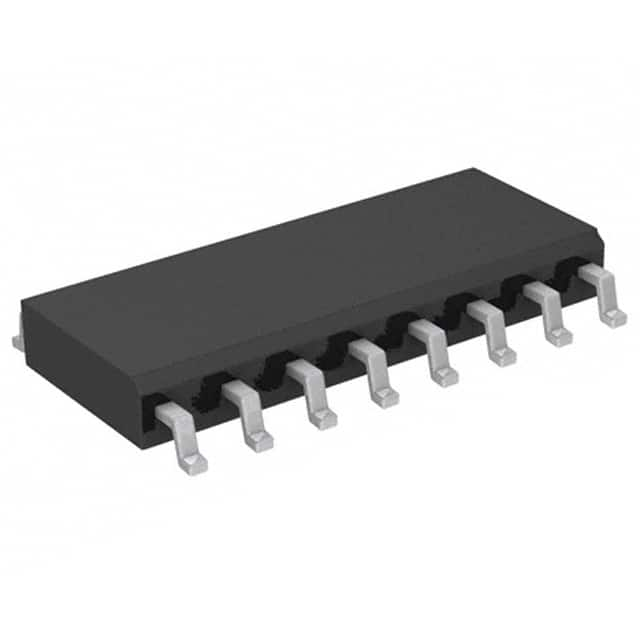74HC165D-Q100,118
Basic Information Overview
- Category: Integrated Circuit (IC)
- Use: Shift Register
- Characteristics: Serial-In, Parallel-Out (SIPO) shift register with 8-bit storage capability
- Package: SOIC (Small Outline Integrated Circuit)
- Essence: Data storage and transfer device
- Packaging/Quantity: Tape and Reel, 2500 units per reel
Specifications
- Supply Voltage Range: 2V to 6V
- Input Voltage Range: -0.5V to VCC + 0.5V
- Output Voltage Range: -0.5V to VCC + 0.5V
- Operating Temperature Range: -40°C to +125°C
- Maximum Clock Frequency: 25 MHz
- Maximum Propagation Delay: 60 ns
- Number of Inputs: 1 (Serial Data Input)
- Number of Outputs: 8 (Parallel Data Outputs)
Detailed Pin Configuration
- GND (Ground)
- SER (Serial Data Input)
- QA (Parallel Data Output A)
- QB (Parallel Data Output B)
- QC (Parallel Data Output C)
- QD (Parallel Data Output D)
- QE (Parallel Data Output E)
- QF (Parallel Data Output F)
- QG (Parallel Data Output G)
- QH (Parallel Data Output H)
- SH/LD (Shift/Load Input)
- CLK (Clock Input)
- MR (Master Reset Input)
- VCC (Supply Voltage)
Functional Features
- Serial-in, parallel-out operation
- 8-bit storage capability
- Asynchronous master reset
- Shift/Load control input for data transfer
- Wide supply voltage range for flexibility
- High-speed operation up to 25 MHz clock frequency
- Low power consumption
Advantages and Disadvantages
Advantages: - Compact SOIC package for space-saving designs - Wide operating temperature range for versatile applications - High-speed operation enables quick data transfer - Low power consumption for energy-efficient systems
Disadvantages: - Limited number of parallel outputs (8 bits) - Requires external clock signal for proper functioning
Working Principles
The 74HC165D-Q100,118 is a serial-in, parallel-out shift register. It receives data serially through the SER pin and stores it internally. The stored data can be transferred to the parallel output pins (QA to QH) by asserting the SH/LD input. The CLK input controls the shifting of data from one stage to another. The MR input allows asynchronous resetting of the register.
Detailed Application Field Plans
- Data acquisition systems
- Industrial automation
- Communication devices
- LED matrix control
- Robotics
- Automotive electronics
- Gaming consoles
- Instrumentation
Detailed and Complete Alternative Models
- SN74HC165N - DIP (Dual Inline Package) version of the same shift register
- CD74HC165E - PDIP (Plastic Dual Inline Package) version with extended temperature range
- MC74HC165ADR2G - SOIC version with enhanced ESD protection
- 74HCT165 - Similar shift register with TTL (Transistor-Transistor Logic) compatible inputs
(Note: These alternative models are not exhaustive and serve as examples.)
Word count: 346 words
Lista 10 Vanliga frågor och svar relaterade till tillämpningen av 74HC165D-Q100,118 i tekniska lösningar
Sure! Here are 10 common questions and answers related to the application of 74HC165D-Q100,118:
Q: What is the 74HC165D-Q100,118? A: The 74HC165D-Q100,118 is a high-speed CMOS 8-bit parallel-in/serial-out shift register with asynchronous reset.
Q: What is the operating voltage range for the 74HC165D-Q100,118? A: The operating voltage range is typically between 2V and 6V.
Q: How many inputs can the 74HC165D-Q100,118 handle? A: The 74HC165D-Q100,118 has 8 parallel inputs.
Q: Can the 74HC165D-Q100,118 be used for both parallel and serial data transfer? A: Yes, the 74HC165D-Q100,118 can be used for both parallel and serial data transfer.
Q: What is the maximum clock frequency for the 74HC165D-Q100,118? A: The maximum clock frequency is typically 25 MHz.
Q: Does the 74HC165D-Q100,118 have an internal pull-up resistor? A: No, the 74HC165D-Q100,118 does not have an internal pull-up resistor.
Q: Can the 74HC165D-Q100,118 be cascaded to increase the number of inputs? A: Yes, multiple 74HC165D-Q100,118 chips can be cascaded together to increase the number of inputs.
Q: What is the power consumption of the 74HC165D-Q100,118? A: The power consumption is typically low, making it suitable for battery-powered applications.
Q: Does the 74HC165D-Q100,118 have any built-in protection features? A: Yes, the 74HC165D-Q100,118 has built-in ESD protection on all inputs and outputs.
Q: What are some common applications of the 74HC165D-Q100,118? A: The 74HC165D-Q100,118 is commonly used in applications such as data acquisition systems, digital control panels, and parallel-to-serial data conversion.
Please note that the answers provided here are general and may vary depending on specific datasheet specifications and application requirements.


